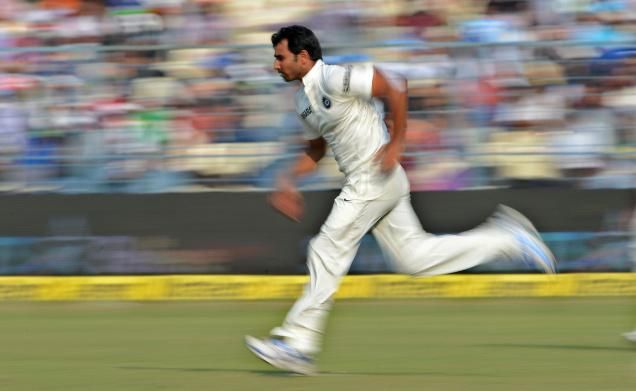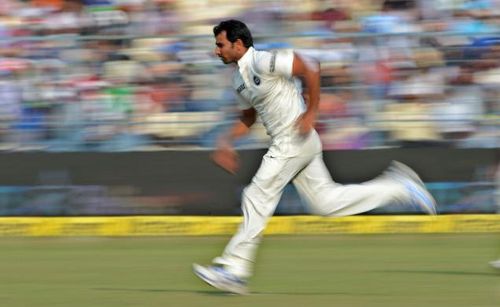
India vs West Indies 2013: Why everyone needs to calm down about Mohammed Shami

There’s a world of trial awaiting Mohammed Shami
Sometimes indirectly, and sometimes with a rider in place, 23-year-old Mohammed Shami has already been compared to Waqar Younis.
A 9-wicket-haul on debut is a big thing, especially when you are a fast bowler, and more so when you have grabbed the limelight with a sensational show of swing bowling. But however talented Mohammed Shami is, and however great the returns from his Test debut were, the world really needs to calm down about the latest pace sensation from India.
It’s a very common tendency in India, and in the same breath, Indian cricket, to blow things out of proportion. Ishant Sharma, Irfan Pathan, RP Singh and Munaf Patel have been the recipients of over-the-top praise in Indian cricket in the past, and their examples are clear warnings for young pacers like Shami to not take a single milestone as a pointer of future greatness.
When Munaf Patel made his debut in 2006, he bowled fast, hurried onto the batsmen and broke stumps with prodigious swing. Seven years later, it’s safe to say that Munaf’s career will best be remembered for how he transformed into a slow-medium pacer and became a source of ridicule for the fans; a sad fall from the image of an express pace spearhead Indians once dreamt of.
This tendency to over-hype is not totally unjustified. India’s thirst for a pace sensation has been unquenched since the days of Kapil Dev. And in a country of a billion, where batting genius is so commonplace that the discards are good enough to make it to the first XI of most teams around the world, it’s the dream of having that elusive fast bowler who can traumatise batsmen around the world which makes fans jump at the very sight of someone like Shami.
But while batting is a graceful art, fast bowling is an unnatural exercise for the human body. Countless potential superstars have lost the battle against fitness to last long enough at the international stage.
Take the example of Varun Aaron. Two years ago, against the same opposition currently touring India, Aaron made his debut in Mumbai. Reams and reams of praise followed, portraying him and Umesh Yadav as the next-look Indian bowling attack, breaking the shackles of slow-medium pace, and finally graduating to express speed. And then Aaron got injured.
However ridiculous it sounds, the youngster from Jamshedpur has suffered two stress fractures in his back already at the age of 24! The ongoing Karnataka vs Jharkhand match in Ranji Trophy is his first competitive match in more than 15 months, which he spent in rehabilitation.
Taking care of fast bowling resources is a perennial problem in Indian cricket. A country like Pakistan may be casual in its approach towards pacers, who emerge left, right and centre on its canvas, but for a team like India, to find a young pace bowler, mark him for the future, and then let him lose the battle for fitness is just unaffordable. It makes one question whether this country has enough experience to be imparted to these upcoming bowlers, particularly in the field of long-term fitness.
And here comes into focus our hero of the day, Mohammed Shami.
He was sensational in Kolkata. The Bengal pacer stuck to great lines and lengths, and produced the kind of swing which must have surely reminded Sachin Tendulkar of his debut series in Pakistan. Yes, it was that kind of bowling. And yet, there’s a long, long way to go for Shami to really let that dream take a definitive shape.

Is Mohammed Shami fit enough to keep his pace and swing intact for more than a series?
Fitness
“He has the pace, he has the ability to trouble batsmen, and we will also be working at ensuring he keeps his fitness levels over a length of time,” MS Dhoni on Mohammed Shami.
The Achilles’ heel of many potential pacers before him, fitness is the main component of Shami’s persona that has to be monitored regularly. If he’s to play the role of a wicket-taker for India, he can’t compromise on his fitness.
What gives Shami an edge over others is his ability to reverse the ball i.e. to move the ball into the right-hander, towards the shiny side of the ball, and hit timber. Those in-swinging beauties make Shami an irresistible prospect for Team India. And he delivers regularly in the 140 kph area.
But his speed and swing are not disconnected features. The moment his pace goes down, he’ll find it harder to reverse swing the ball. And the moment his fitness levels go down, he’ll lose his edge over others. His pace will drop; in the absence of reverse swing, he may yet get some movement off the pitch due to his immaculate seam positioning, but he’ll start his journey down that much dreaded path of failed dreams.
It’s not a fast bowler’s game any more, and it’s extremely important that Dhoni and Co shield him from formats where his presence is not necessary. They need to manage his workload in an optimum way, something the BCCI hasn’t been famous for over the years, unfortunately.
Bigger challenges
By any stretch of the imagination, West Indies do not possess the best batting line-up in the world, and at home, on a ground he’s so familiar with, Shami hasn’t faced the most difficult challenge in his international career yet.
India travel to South Africa, New Zealand, England and Australia over the next year or so, and therein lie the chances of Shami’s trial by fire.
As early as next month, Shami may be bowling at the likes of Hashim Amla, Graeme Smith and AB de Villiers on the bouncy pitches of South Africa. He’ll have the perfect mix of conventional swing that would be on offer and his killer in-swingers in between, and how he learns from that experience will be a telling way of measuring the young man’s grasping abilities.
New Zealand, England and Australia present their unique set of challenges, and having not seen Shami beyond a single Test, it’ll be a cardinal sin on our part to pronounce him Indian bowling’s greatest find in the past decade.
The young boy has just started his journey. And despite it having been a fantastic trailer, let’s reserve our judgement until we have seen the complete movie.